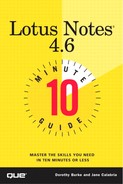Understanding Databases
A Notes database contains a collection of documents technically termed Notes and is used to manage large amounts of related information. Notes Databases enable you to share information contained in these documents that can include externally created files such as text files, spreadsheets, graphics, and tables.
Notes databases typically fall into one of the following categories:
Broadcast Information or current events that are updated frequently and accessed by many people who need to keep informed on certain subjects. Typical broadcast databases or applications are newsletters, industry news bulletins, or postings of meeting agendas and minutes.
Reference Online libraries of reference information that are periodically updated. Company policies and procedure manuals, software and hardware documentation, employee benefits information and technical support information are all examples of reference applications and databases.
Discussion Databases that enable participants to read one another's contributions and respond to them if they want. Discussion databases differ from email messages in that all the contributing documents are kept in one database, accessible by many people. A discussion database might be used for brainstorming ideas, suggestion boxes, or for polling opinions.
Tracking Perfect for following the status of a project that changes rapidly and projects to which multiple people contribute frequent updates. Typical tracking applications include sales call tracking, project management, customer service, service calls, event planning, and collections management.
Workflow Automation of routine tasks. Workflow applications or databases are used for purchase requests, to handle insurance claims, to submit and approve expense reports, or to route loan approvals.
Mail The Notes mail database combines many of the features of the categories in this list and is used to read, send, and receive your email.
Most of the Notes databases you use do not come "ready-made" with Notes but, instead, are designed by Application Developers specifically for your company. The exceptions are the Mail, Favorites, Web Navigator and Address databases, which are included with Notes for every Notes user.
While you are at work and connected to the Domino server, most of the databases you access reside on the server. The icons representing your databases (such as mail) are only pointers to the databases on the server. If you are a remote, or mobile, user you must make a special kind of copy—called a replica—of each database you need to work with when you are disconnected from the Domino server. A replica of the database is a special copy that enables you to read, edit, and create documents and send changes you make back to the server the next time you connect to the server. For more information on replication, see Lesson 11 "Creating Database Replicas" and for more information on working remotely, see Lesson 23, "Using Notes Remotely."
